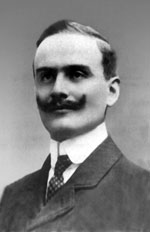Volume 23, Number 9—September 2017
Etymologia
Etymologia: Negri Bodies
Negri bodies (Figure 1) are cytoplasmic inclusions in neurons that are composed of rabies virus proteins and RNA. Adelchi Negri (Figure 2), an assistant pathologist working in the laboratory of Camillo Golgi, observed these inclusions in rabbits and dogs with rabies. These findings were presented in 1903 at a meeting of the Società Medico-Chirurgica of Pavia. Negri was convinced the inclusions were a parasitic protozoon and the etiologic agent of rabies. Later that same year, however, Paul Remlinger and Rifat-Bey Frasheri in Constantinople and, separately, Alfonso di Vestea in Naples showed that the etiologic agent of rabies is a filterable virus. Negri continued until 1909 to try to prove that the intraneuronal neurons named after him corresponded to steps in the developmental cycle of a protozoan. In spite of his incorrect etiologic hypothesis, Negri’s discovery represented a breakthrough in the rapid diagnosis of rabies, and the detection of Negri bodies was used for many years until the development of modern diagnostic methods.
References
- Centers for Disease Control and Prevention. Histologic examination. Apr 22, 2011 [cited 2017 Jun 21]. https://www.cdc.gov/rabies/diagnosis/histologic.html
- Di Vestea A. On the finding of the filtration of the virus of anger [in Italian]. Ann Ig Sper. 1905;15:147.
- Jackson AC. Rabies and other rhabdovirus infections. In: Longo DL, Fauci AS, Kasper DL, Hauser SL, Jameson JL, Loscalzo J, editors. Harrison’s principles of internal medicine. 18th ed. New York: McGraw Hill; 2012. p. 1611–7.
- Remlinger PA, Frasheri RB. Rabies virus crosses the Berkefeld filter [in French]. Comptes Rendus de la Société de Biologie. 1903;55:730–1.
Figures
Cite This ArticleRelated Links
Table of Contents – Volume 23, Number 9—September 2017
| EID Search Options |
|---|
|
|
|
|
|
|


Please use the form below to submit correspondence to the authors or contact them at the following address:
Ronnie Henry, Centers for Disease Control and Prevention, 1600 Clifton Rd NE, Mailstop E03, Atlanta, GA 30329-4027, USA
Top